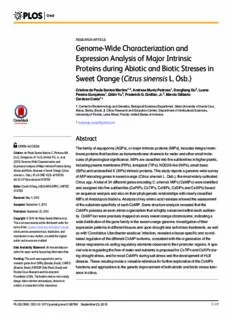
Genome-Wide Characterization and Expression Analysis of Major Intrinsic Proteins during Abiotic PDF
Preview Genome-Wide Characterization and Expression Analysis of Major Intrinsic Proteins during Abiotic
RESEARCHARTICLE Genome-Wide Characterization and Expression Analysis of Major Intrinsic Proteins during Abiotic and Biotic Stresses in Citrus sinensis Sweet Orange ( L. Osb.) CristinadePaulaSantosMartins1,2,AndresaMunizPedrosa1,DongliangDu2,Luana PereiraGonçalves1,QibinYu2,FrederickG.Gmitter,Jr.2,MarcioGilberto CardosoCosta1* 1 CenterforBiotechnologyandGenetics,BiologicalSciencesDepartment,StateUniversityofSantaCruz, Ilhéus,Bahia,Brazil,2 CitrusResearchandEducationCenter,DepartmentofHorticulturalSciences, UniversityofFlorida,LakeAlfred,Florida,UnitedStatesofAmerica *[email protected] Abstract OPENACCESS Thefamilyofaquaporins(AQPs),ormajorintrinsicproteins(MIPs),includesintegralmem- Citation:dePaulaSantosMartinsC,PedrosaAM, braneproteinsthatfunctionastransmembranechannelsforwaterandothersmallmole- DuD,GonçalvesLP,YuQ,GmitterFG,Jr.,etal. culesofphysiologicalsignificance.MIPsareclassifiedintofivesubfamiliesinhigherplants, (2015)Genome-WideCharacterizationand ExpressionAnalysisofMajorIntrinsicProteinsduring includingplasmamembrane(PIPs),tonoplast(TIPs),NOD26-like(NIPs),smallbasic AbioticandBioticStressesinSweetOrange(Citrus (SIPs)andunclassifiedX(XIPs)intrinsicproteins.Thisstudyreportsagenome-widesurvey sinensisL.Osb.).PLoSONE10(9):e0138786. ofMIPencodinggenesinsweetorange(CitrussinensisL.Osb.),themostwidelycultivated doi:10.1371/journal.pone.0138786 Citrusspp.Atotalof34differentgenesencodingC.sinensisMIPs(CsMIPs)wereidentified Editor:DavidDFang,USDA-ARS-SRRC,UNITED andassignedintofivesubfamilies(CsPIPs,CsTIPs,CsNIPs,CsSIPsandCsXIPs)based STATES onsequenceanalysisandalsoontheirphylogeneticrelationshipswithclearlyclassified Received:May1,2015 MIPsofArabidopsisthaliana.Analysisofkeyaminoacidresiduesallowedtheassessment Accepted:September3,2015 ofthesubstratespecificityofeachCsMIP.Genestructureanalysisrevealedthatthe Published:September23,2015 CsMIPspossessanexon-intronorganizationthatishighlyconservedwithineachsubfam- ily.CsMIPlociwerepreciselymappedoneverysweetorangechromosome,indicatinga Copyright:©2015dePaulaSantosMartinsetal. Thisisanopenaccessarticledistributedunderthe widedistributionofthegenefamilyinthesweetorangegenome.Investigationoftheir termsoftheCreativeCommonsAttributionLicense, expressionpatternsindifferenttissuesandupondroughtandsaltstresstreatments,aswell whichpermitsunrestricteduse,distribution,and aswith‘CandidatusLiberibacterasiaticus’infection,revealedatissue-specificandcoordi- reproductioninanymedium,providedtheoriginal natedregulationofthedifferentCsMIPisoforms,consistentwiththeorganizationofthe authorandsourcearecredited. stress-responsivecis-actingregulatoryelementsobservedintheirpromoterregions.Aspe- DataAvailabilityStatement:Allrelevantdataare cialroleinregulatingtheflowofwaterandnutrientsisproposedforCsTIPsandCsXIPsdur- withinthepaperanditsSupportingInformationfiles. ingdroughtstress,andformostCsMIPsduringsaltstressandthedevelopmentofHLB Funding:Thisworkwassupportedinpartby disease.TheseresultsprovideavaluablereferenceforfurtherexplorationoftheCsMIPs researchgrantsfromCNPq(Brasília,Brazil),CAPES (Brasília,Brazil),FAPESP(SãoPaulo,Brazil)and functionsandapplicationstothegeneticimprovementofbothabioticandbioticstresstoler- FloridaCitrusResearchandDevelopment anceincitrus. Foundation(USA).Thefundershadnoroleinstudy design,datacollectionandanalysis,decisionto publish,orpreparationofthemanuscript. PLOSONE|DOI:10.1371/journal.pone.0138786 September23,2015 1/17 Genome-WideCharacterizationofSweetOrangeMIPs CompetingInterests:Theauthorshavedeclared Introduction thatnocompetinginterestsexist. Aquaporins(AQPs)areintegralmembraneproteinsthatassisttherapidmovementofwateras wellasotherlowmolecularweightmoleculesacrosscellularmembranes[1–3].AQPsbelongto theancientfamilyofmajorintrinsicproteins(MIPs)foundinmicroorganisms,plantsandani- mals.WhileasmallnumberofdifferentAQPshavebeenidentified(2inE.coli,9inS.cerevisiae, 11inC.elegansand13inmammals[4]),asurprisinglylargenumberofMIPhomologueshave beenfoundinplants;forexample,35AQPswerefoundinArabidopsis[5],36inZeamays[6], 33inOryzasativa[7],28inVitisvinifera[8],55inPopulustrichocarpa[9],71inGossypium hirsutum[10],47inSolanumlycopersicum[11]and66inGlycinemax[12].Theseobservations highlightamajorroleforplantMIPsaskeyregulatorsoftheintricateflowsofwaterandsolutes requiredforgrowthandadaptiveresponsestotheever-changingenvironment. PlantMIPswereoriginallycategorizedintofoursubfamiliesonthebasisofsequencehomol- ogiesandsubcellularlocalization:plasmamembrane(PIP),tonoplast(TIP),nodulin-like(NIP) andsmallbasic(SIP)intrinsicproteins[2,13].Morerecently,studiesinthemossPhyscomitrella patensrevealedthepresenceofnovelAQPisoformsinadditiontothefourconservedplant AQPsubfamilies:ahomologueoftheEscherichiacoliintrinsicproteinGlpF(GIPs),intrinsic hybridproteins(HIPs)andunclassifiedXintrinsicproteins(XIPs)[9,13–17].XIPhomologues havealsobeenidentifiedinsomehigherplants,suchasSolanumlycopersicum,Populustricho- carpaandGlycinemax[9,11,12,15].ThesefindingssuggestthatthefamilyofplantMIPsis largerandmuchmorecomplexthanpreviouslyanticipatedand,hence,mayplaycriticalroles inawiderangeofbiologicalprocessesthatgofarbeyondthecurrentknowledge. AQP-mediatedwatertransportinplantshasbeenimplicatedtoplayacentralregulatorystep indiversebiologicalprocesses,includingcellelongation,seedgerminationandosmoregulation [18].Inaddition,AQPsfacilitatethetransportofsmallunchargedmoleculesofphysiological significancelikeglycerol,urea,boricacid,silicicacid,hydrogenperoxide(H O ),ammonia 2 2 (NH )andcarbondioxide(CO )throughtheplantcellmembranes[1,2]andalsoregulate 3 2 phloemsaploadingandunloading,stomatalandleafmovement,andcytoplasmichomeostasis [1,2,13,19].Therefore,itisnotsurprisingthattheirexpressionandbiologicalactivitieshave beenshowntobedevelopmentallyanddifferentiallyregulatedinacell-specificmanner,viaphy- tohormonessuchasabscisicacid(ABA),gibberellinsandpossiblybrassinosteroids,andbyenvi- ronmentalsignalssuchaslight,waterstress,nematodeinfection,lowtemperature,andsalinity [4].However,ageneralexpressionpatternamongthedistinctMIPisoformscannotbedistin- guished,astheyareeitherup-ordownregulateddependingonthestimulusand/orthecell-type studied[4,19,20].ThisdifferenceintranscriptionalregulationsuggeststhateachMIPisoform mayplayadistinctroleinplantgrowth,developmentandstressresponse[4]. Asamajorhorticulturalcrop,thecultivatedCitrusspp.faceconstantbioticandabioticcon- straintsinthemainregionsofproduction,includingdrought,salinity,extremetemperatures andseriousdiseaseslikeHuanglongbing(HLB,orcitrusgreening),whicharepredictedto increaseinintensity,frequency,andgeographicextentasaconsequenceofglobalclimate change.DespitethehighlightedimportanceofAQPs,thereareonlyafewstudiestodateoncit- rusMIPsandtheirpredictedroleinthetransportofwaterandsolutesrequiredforplant growth,developmentandadaptiveresponsestotheenvironment.TheexpressionoftwoMIP genes,PIP1andPIP2,hasbeeninvestigatedinrootsofPoncirustrifoliata(L.)Raf.,Cleopatra mandarin(C.reshniHortexTan.)andoneoftheirhybrids,subjectedtomoderatewaterdeficit [21],andinrootsofP.trifoliata,CleopatramandarinandCarrizocitrange(C.sinensis[L.] Osb.×P.trifoliata[L.]Raf.),subjectedtosalttreatment[22].PIP1andPIP2geneexpressiondif- ferenceswerecorrelatedwithalterationsinroothydraulicconductance(Kr)andchloride(Cl-) exclusionfromleavesand,hence,tolerancetowaterandsaltstresses,respectively.Withthe PLOSONE|DOI:10.1371/journal.pone.0138786 September23,2015 2/17 Genome-WideCharacterizationofSweetOrangeMIPs recentcompletionandpublicationofthegenomesequencesofsweetorange[23–25],itisnow possibletoidentifyandcharacterizethecompleterepertoireofMIPsincitrus,aswellastocarry outcomparativegenomeanalysisinordertounderstandtheirevolutionaryhistory.Therefore, theobjectiveofthepresentstudywastoidentifysweetorangeMIPgenesthroughagenome- wideanalysisandtocharacterizetheirsequences,evolutionaryrelationships,putativefunctions andexpressionpatternsinvarioustissuesandinresponsetoabioticandbioticstresses.Thisis thefirstcomprehensivestudyoftheMIPgenefamilyinsweetorange,providingvaluableinfor- mationforfurtherexplorationofthefunctionsofthisimportantgenefamilyincitrus. MaterialsandMethods Plantmaterialsandstresstreatments Two-year-oldsweetorangeplantsgraftedonRangpurlime(C.limoniaOsbeck),arootstock highlyresistanttodrought,wereusedinthedroughtstressexperiment.Plantswerefirst prunedandacclimatizedtogreenhouseconditions(25±4°C,16hoflightandrelativehumidity oscillatingbetween80and95%)during90daystoobtainadequaterootdevelopmentanduni- formleafflushes.Duringacclimatization,plantsweregrowninplasticpotsof45-L,containing amixtureofsoilandsand(ratio3:1)andmicronutrientmixFTE(50gperpot),irrigatedwith tapwatertwiceaweek,andfertilizedweeklywith1literofthefollowingnutrientsolution:1.0g l-1Ca(NO ) ,0.4gl-1KNO ,0.6gl-1MgSO and0.4gl-1NH H P0 (MAP).Thereafter,the 3 2 3 4 4 2 4 potswereclosedwithaluminumfoiltopreventwaterlossbyevaporation,andasetof10plants wasrandomizedovertheexperimentalareaandsubjectedtothefollowingtreatments:(i)5 plantsincontrol,inwhichplantsweremaintainedatleafpredawnwaterpotentialvaluesof -0.2to-0.4MPabydailyirrigationand(ii)5plantsindrought,inwhichtheplantswere exposedtoaprogressivesoilwaterdeficituntiltheirleavesreachpredawnwaterpotentialval- uesof-1.5MPa.Theleafpredawnwaterpotentialwasrecordedonthethirdfullyexpanded matureleaffromtheapexofeachplant,between2AMand4AM,usingaScholander-type pressurepump(m670,PmsInstrumentCo.,Albany,USA). Forsalttreatment,sweetorangeseedsweregerminatedinvitroasdescribedbydeOliveira etal.[26].Twenty-day-oldseedlingsofnucellaroriginwereselectedbasedontheiruniformity, andtransferredtoMSmediumalone(control)orcontaining150mMNaCl(Merck,Darm- stadt,Germany).Eachtreatmentconsistedof15nucellarplants(biologicalreplicates).Leaves androotswereharvested20daysafterthetreatmentsandimmediatelyfrozeninliquidnitro- genandstoredat-80°C. Plantswereinfectedwith‘CandidatusLiberibacterasiaticus’asdescribedinFanetal.[27]. Briefly,two-year-oldseedlingsofroughlemon(C.jambhiriLush.)andsweetorange(C.sinen- sisL.Osbeck)weregraft-inoculatedwithbudwoodfrom‘Ca.L.asiaticus’infected‘Carrizo’ citrangetreeskeptundergreenhouseconditions.Forcontrols,theplantsweregraftedwithbud woodfromhealthyCarrizotrees.AlltheseplantswerekeptinaUnitedStatesDepartmentof AgricultureAnimalandPlantHealthInspectionServiceandCenterforDiseaseControl- approvedandsecuredgreenhouseattheUniversityofFlorida,CitrusResearchandEducation Center,LakeAlfred.Threebiologicalreplicateswereproducedforeachcitrusspeciesineach treatment.Quantitativereal-timePCRwasperformedtoconfirmthepresenceof‘Ca.L.asiati- cus’intheinoculumsourceandinoculatedplantsasdescribedinLietal.[28].Fourfully expandedleavesweresampledseparatelyfrom‘Ca.L.asiaticus’inoculatedplantsandmock- inoculatedplants(usedascontrols)ofeachcitrusspeciesat0,7,17,and34weeksafterinocula- tion(WAI).Leaveswereimmediatelyfrozeninliquidnitrogenandstoredat-80°Cuntiluse. Threebiologicalreplicateswereproducedforeachcondition.Intotal,12plantswith48leaf sampleswerecollected(2speciesx2treatmentsx3replicatesx4timepoints). PLOSONE|DOI:10.1371/journal.pone.0138786 September23,2015 3/17 Genome-WideCharacterizationofSweetOrangeMIPs IdentificationandclassificationofCsMIPs TheHiddenMarkovModelprofileofthePFAM(http://pfam.sanger.ac.uk/)[29]motif PF00230(majorintrinsicprotein)wasusedasakeywordtosearchthesweetorangegenome sequencedatabase(http://www.phytozome.org/citrus/)[25].TheKEGGOrthology(KO) termsK09872(aquaporinPIP),K09873(aquaporinTIP),K09874(aquaporinNIP)and K09875(aquaporinSIP)werealsousedaskeywordstosearchthesweetorangegenome sequenceatPhytozome.Toavoidthedeficienciesoftheautomaticannotation,the35Arabi- dopsisthalianaMIPproteinsequenceswereretrievedfromTAIR(http://www.arabidopsis.org/ ),accordingtopreviousreports[5,30],andalsousedtoalignwiththesweetorangegenome sequenceassemblyavailableatPhytozomeusingtheTBLASTNtool.Aftermergingtheresults fromallthesestrategies,uniqueentries(withuniquelocusID)wereidentifiedtoremovethe redundancy.Theresultingsequencesweremanuallyinspectedforthepresenceofcharacteris- ticandfunctionallyimportantMIPaminoacidsandmotifs. ThesweetorangeMIPswereclassifiedindifferentisoformsbasedonsequenceanalysisof themultiplealignmentsandontheirphylogeneticrelationshipwiththoseclearlyclassified MIPsofArabidopsisthaliana,RicinuscommunisandNicotianabenthamiana,downloaded fromtheTAIRandNCBIdatabases.Multiplesequencealignmentsofthededucedaminoacid sequencesofCsMIPsandthoseofA.thaliana,R.communisandN.benthamianawereper- formedusingthedefaultparametersofClustalW[31].Thedendrogramwasgeneratedbythe MEGA6program[32]usingtheNeighbor-Joining(NJ)method[33]andbootstrapanalysis (1,000replications). AnalysisofCsMIPproteinpropertiesandconservedaminoacid residues Informationaboutcodingsequence(CDS),full-lengthsequenceandpredictedaminoacid sequencewasobtainedforeachsweetorangeMIPgenefromthePhytozomedatabase.The GRAVY(grandaverageofhydropathy),molecularweightandisoelectricpoint(pI)ofthe deducedaminoacidsequenceswerepredictedbythePROTPARAMtoolavailableonthe ExpertProteinAnalysisSystem(ExPASy)proteomicsserver(www.expasy.ch/tools/protparam. html).ThesubcellularlocalizationofMIPproteinswaspredictedusingtheWoLFPSORTtool availableathttp://www.genscript.com/psort/wolf_psort.html.Carefulvisualinspectionof aminoacidsequencealignmentswereperformedtoidentifythecharacteristicMIPamino acidsandmotifsandtheresiduesinsevenkeypositionsthathavebeenreportedtobespecific foreachfunctionalsubgroup[12,30,34,35]. AnalysisofpromotersequencesandchromosomallocationsofCsMIPs Onekbupstreamregionfromthetranslationstartsitewasextractedfromallthesweetorange MIPgenesandsubsequentlyanalyzedinthePLACEdatabase(http://www.dna.affrc.go.jp/ PLACE/signalscan.html)toidentifythepresenceofthestress-responsivecis-actingregulatory elementsABRE(ABA-responsiveelement;ACGTG),DRE/CRT(dehydrationresponsiveele- ment/C-repeat;G/ACCGAC),MYBS(MYBbindingsite;TAACTG)andLTRE(low-tempera- ture-responsiveelement;CCGAC)intheirpromoters.ThephysicallocationsofCsMIPswere determinedbyconfirmingthestartingpositionofallgenesoneachchromosome,using BLASTNsearchingagainstthelocaldatabaseoftheCitrussinensisAnnotationProject(CAP; http://citrus.hzau.edu.cn/orange/).MapChartsoftwarewasusedtoplotthegenelocionthe sweetorangechromosomes[36]. PLOSONE|DOI:10.1371/journal.pone.0138786 September23,2015 4/17 Genome-WideCharacterizationofSweetOrangeMIPs ExpressionanalysisofCsMIPs TotalRNAisolation,cDNAsynthesisandquantitativereal-timeRT-PCR(qPCR)analysis wereperformedasdescribedpreviously[26].qPCRprimersweredesignedappropriatelyto avoidtheconservedregions.PrimersequencesareshownindetailinS1Table.Glyceralde- hyde-3-phosphatedehydrogenaseC2(GAPC2)wasusedasaninternalreferencegenetonor- malizeexpressionamongthedifferentsamples[37].Datawereobtainedfromapoolofthree biologicalreplicatesthatwereindividuallyvalidated. RNA-seqdataweredownloadedfromCAP[24]andusedtoanalyzetheexpressionpatterns ofCsMIPsindifferenttissues,namelycallus(C),flower(Fl),leaf(L),fruit(Fr),andmixedtis- suesfromfruitatthreedevelopmentalstages(Mix.1,Mix.2,andMix.3).Theheatmapwasgen- eratedusingR3.1.0software. ResultsandDiscussion MIPencodinggenesinthesweetorangegenome SearchesinthesweetorangegenomesequencedatabaseatPhytozomeusingannotationinfor- mation,aswellasthe35proteinsequencesofthecompletesetofA.thalianaMIPs(AtMIPs) asquerysequences,resultedintheidentificationof34differentgenesencodingC.sinensis MIPs(CsMIPs)(Table1).Theretrievedsequencesweremanuallyinspectedforthepresenceof characteristicandfunctionallyimportantMIPdomainsandmotifs,suchasthehighlycon- servedNPA(Asn-Pro-Ala)motifs,andconsideredtobecorrect.ThenumberofMIPgenes describedinthisstudyissimilartothatfoundinthegenomesofArabidopsis[5],maize[6], rice[7]andgrape[8],butsignificantlylowerthanthatidentifiedinthegenomesofpoplar[9], cotton[10],tomato[11]andsoybean[12].Theabsenceofrecentwhole-genomeduplication (WGD)eventsinthesweetorangegenome,asdescribedbyXuetal.[23],couldaccountfor therelativelysmallsizeoftheMIPfamilyinthecitrusgenome. TheCsMIPswereclassifiedinfivedifferentsubfamilies,PIPs,TIPs,NIPs,SIPsandXIPs, basedonanalysisoftheaminoacidresidueslocatedinsevenkeypositions(P1toP7)thatwere previouslyproposed[12,34,35]todiscriminatethedifferentsubfamilies(S2Table),aswellas ontheirphylogeneticrelationshipswiththewellclassifiedMIPsofA.thalianaandXIPsofR. communisandN.benthamiana(S1Fig).Ouranalysisrevealedthepresenceof8PIPs,11TIPs, 9NIPs,3SIPsand3XIPsinthesweetorangegenome(Table1).TheCsMIPswerenamed accordingtothenomenclatureproposedinclassificationoftheMIPsofA.thaliana.This nomenclaturewasbasedonphylogeneticanalysesandwherethenamesinasystematicway reflectdistinctcladesthatareevolutionarilystable[5].PIPs,TIPs,NIPsandSIPsfromsweet orangegroupedwiththeirrespectiveArabidopsiscounterparts,indicatingthelargeextentof conservationbetweenthesweetorangeandArabidopsisMIPgenefamilies(S1Fig).Theonly exceptionwasCsTIP6;1,whichwasfoundtoencodeaN-andC-terminallytruncatedTIPpro- teincomparedtotherestofthesubfamily. ToexaminewhetherthenumberofMIPgenesfoundinthediploidsweetorangeiscompa- rabletothatofthedihaploidsweetorangeandhaploidClementinemandarin,wealsoper- formedhomologysearchesagainstthedihaploidsweetorangedraftgenomeavailableatthe CitrussinensisAnnotationProject(CAP)andthereferencehaploidClementinemandarin(C. clementina)genomeavailableatPhytozome(S3Table).AlthoughthetotalnumberofMIP geneswasroughlysimilaramongthedifferentcitrusgenomes,significantdifferenceswere observedinthenumberofmemberswithinthesubfamilies(Table2).BLASTsimilarityanaly- sisrevealedthatthedihaploidsweetorangeandhaploidClementinecontainedtwoadditional PIPisoformscloselyrelatedtotheCsPIP2;1(S3Table).Clementinealsocontainedone PLOSONE|DOI:10.1371/journal.pone.0138786 September23,2015 5/17 Genome-WideCharacterizationofSweetOrangeMIPs Table1. GenesandencodedMIPproteinsinsweetorange. Gene Locus Chromosomelocation Group Kegg Polypeptide pI GRAVY Predictedsubcellular name OrthID length(MW) localization CsPIP1;1 orange1.1g018895m chr7:31,253,722...31,256,103 PIP K09872 349(37.56kDa) 9.39 0.397 plasmamembrane CsPIP1;2 orange1.1g023021m chr7:31,247,369...31,248,902 288(30.67kDa) 7.71 0.414 plasmamembrane CsPIP1;3 orange1.1g023107m chr5:1,804,896...1,807,677 287(30.70kDa) 8.97 0.344 plasmamembrane CsPIP1;4 orange1.1g023069m chr6:9,907,825...9,909,541 287(30.82kDa) 8.96 0.343 plasmamembrane CsPIP2;1 orange1.1g023108m chr6:12,833,884...12,835,042 287(30.67kDa) 8.74 0.376 plasmamembrane CsPIP2;2 orange1.1g022966m chr8:19,657,287...19,659,497 289(31.05kDa) 7.62 0.392 plasmamembrane CsPIP2;3 orange1.1g019681m chr7:26,202,220...26,205,546 337(36.34KDa) 9.77 0.403 plasmamembrane CsPIP2;4 orange1.1g023370m chr8:981,841...983,571 283(30.14kDa) 8.99 0.431 plasmamembrane CsTIP1;1 orange1.1g025548m chrUn:46,663,407...46,665,011 TIP K09873 251(26.06kDa) 6.12 0.675 vacuole CsTIP1;2 orange1.1g025600m chr8:20,659,157...20,660,437 250(25.65kDa) 5.32 0.841 cytosol CsTIP1;3 orange1.1g037978m chr8:20,659,157...20,660,437 124(12.92kDa) 4.37 0.734 cytosol CsTIP1;4 orange1.1g025464m chr7:29,135,182...29,136,531 252(26.01kDa) 5,69 0,786 vacuole CsTIP2;1 orange1.1g025817m chr1:18,627,617...18,629,472 247(25.15kDa) 5.59 0.894 vacuole CsTIP2;2 orange1.1g025865m chr1:18,627,617...18,629,472 247(25.10kDa) 5.59 0.902 vacuole CsTIP2;3 orange1.1g038895m chr5:5,749,487...5,750,939 206(20.55kDa) 4.72 0.979 vacuole CsTIP3;1 orange1.1g025197m chr5:16,938,542...16,940,192 256(26.99kDa) 7.07 0.626 cytosol CsTIP4;1 orange1.1g025864m chr4:19,032,254...19,033,990 247(16.27kDa) 6.27 0.825 vacuole CsTIP5;1 orange1.1g046726m chr9:14,144,215...14,145,199 161(16.86kDa) 9.00 0.770 cytosol CsTIP6;1 orange1.1g042738m chr9:14,144,215...14,145,199 107(11.11kDa) 4.54 0.636 secreted CsNIP1;1 orange1.1g023184m chr2:2,151,220...2,153,387 NIP K09874 286(30.45kDa) 8.64 0.434 vacuole CsNIP2;1 orange1.1g036721m chr6:18,134,848...18,136,228 223(23.70kDa) 9.69 0.889 cytosol CsNIP2;2 orange1.1g040981m chr6:18,134,848...18,136,228 211(22.32kDa) 9.39 0.967 cytosol CsNIP2;3 orange1.1g040755m chr2:13,464,261...13,465,771 275(29.39kDa) 8.88 0.628 plasmamembrane CsNIP3;1 orange1.1g023102m chr6:20,482,599...20,486,038 287(30.30kDa) 8.40 0.387 plasmamembrane CsNIP4;1 orange1.1g046511m chr3:23,770,831...23,774,009 282(29.28kDa) 8.84 0.372 vacuole CsNIP5;1 orange1.1g035030m chr1:13,680,675...13,682,992 75(7.75kDa) 8.98 0.291 chloroplast CsNIP5;2 orange1.1g027840m chr1:13,678,241...13,681,090 218(22.51kDa) 7.75 0.462 plasmamembrane CsNIP6;1 orange1.1g039196m chr9:3,798,017...3,800,780 288(30.20kDa) 7.53 0.718 plasmamembrane CsSIP1;1 orange1.1g026039m chr5:28,968,880...28,972,401 SIP K09875 244(25.92kDa) 9.35 0.727 plasmamembrane CsSIP1;2 orange1.1g026082m chr3:1,234,876...1,236,556 244(26.17kDa) 9.83 0.749 plasmamembrane CsSIP2;1 orange1.1g026600m chr6:17,078,102...17,081,323 236(25.57kDa) 9.70 0.600 chloroplast CsXIP1;1 orange1.1g036381m chr8:7,139,938...7,141,114 XIP - 235(25.09kDa) 8.70 0.821 plasmamembrane CsXIP1;2 orange1.1g040654m chr8:7,131,064...7,132,799 302(32.68kDa) 8.74 0.573 plasmamembrane CsXIP2;1 orange1.1g045670m chr8:7,128,184...7,129,448 319(34.58kDa) 8.32 0.681 plasmamembrane doi:10.1371/journal.pone.0138786.t001 additionalPIPisoformcloselyrelatedtotheCsPIP1;2andonePIP,TIPandNIPisoformwith- outhomologytoanyMIPsequencefromthediploidsweetorange(S3Table).CsTIP1;2and CsTIP1;3,CsTIP2;1andCsTIP2;2,CsTIP5;1andCsTIP6;1,andCsNIP2;1andCsNIP2;2exhib- itedsignificanthitstothesameMIPisoformsofthedihaploidsweetorangeandhaploidClem- entine(S3Table).TheseobservedvariationsinthesizeoftheMIPsubfamiliesmaybea consequenceofthedifferentsequencingdepthandassemblyqualitybetweenthediploidand dihaploidsweetorangegenomes[23,25]andtheevolutionaryoriginofClementine,whichisa hybridofWillowleafmandarinandsweet-orange[25]and,thereby,itcontainsmoreC.reticu- latahaplotyperegionsthanfoundinsweetorange. PLOSONE|DOI:10.1371/journal.pone.0138786 September23,2015 6/17 Genome-WideCharacterizationofSweetOrangeMIPs Table2. ComparisonofthenumberofthedifferentMIPfamilymembersindiploid(Phytozome)anddihaploid(CAP)sweetoranges(C.sinensis) andhaploidClementine(C.clementina). Subfamily DiploidC.sinensis DihaploidC.sinensis C.clementina PIP 8 10 11 TIP 11 8 9 NIP 9 8 8 SIP 3 3 3 XIP 3 3 2 Total 34 32 33 doi:10.1371/journal.pone.0138786.t002 CsMIPproteinpropertiesandconservedaminoacidresidues TheCsMIPsencodeproteinsrangingfrom75(7.7kDa)to349(37.6kDa)aminoacidsin length,andpIvaluesrangingfrom4.37to9.77(Table1).TheaverageproteinlengthofPIPs, TIPs,NIPs,SIPsandXIPswere300.8(32.2kDa),213.4(21.1kDa),238.3(25.1kDa),241.3 (25.9kDa)and285.3(30.8kDa)aminoacids,respectively.TheaveragepIofPIPs,TIPs,NIPs, SIPsandXIPswere8.77,5.86,8.68,9.63,and8.59,respectively.ThesedatarevealthatCsTIPs arenotonlysmaller,butmostofthemarealsomuchmoreacidicthantheotherCsMIPs,as reportedforArabidopsisMIPs[38].ThecauseoftheselargedifferencesinTIPshasbeenattrib- utedtothesmalleramountofbasicresiduesfoundatthecarboxylterminiofTIPscompared withtheotherMIPs[5].AlltheCsMIPshadapositiveGRAVYscore(Table1),suggestingthat theyarehydrophobicproteins,whichisanecessarycharacteristicforAQPs[1].Analysisofthe predictedsubcellularlocalizationshowedthatallCsPIPsandCsXIPswerelocalizedtoplasma membrane(Table1).ThepredictedlocalizationofCsTIPs,CsNIPsandCsSIPswasmore diverse,includingvacuole(CsTIP1;1,CsTIP1;4,CsTIP2;1,CsTIP2;2,CsTIP2;3,CsTIP4;1, CsNIP1;1andCsNIP4;1),cytosol(CsTIP1;2,CsTIP1;3,CsTIP3;1,CsTIP5;1,CsNIP2;1and CsNIP2;2),plasmamembrane(CsNIP2;3,CsNIP3;1,CsNIP5;2,CsNIP6;1,CsSIP1;1and CsSIP1;2),chloroplast(CsNIP5;1andCsSIP2;1)andsecreted(CsTIP6;1)(Table1).These resultsseemtobeinagreementwiththeexperimentallydeterminedlocalizationsofMIPs reportedintheliterature[13,39]. MIPfoldingischaracterizedbysixtransmembraneα-helices(H1toH6)thatareconnected byfiveloops(loopsA-E),forminganaqueoustransmembraneporethatconstitutesthefunc- tionalcoreofMIPs[35].LoopsB(LB)andE(LE)containtwohighlyconservedNPA(Asn- Pro-Ala)motifsthatareconsideredtobecriticalforthesubstrateselectivityofMIPs[40,41]. Anothersetoffourconservedresiduesformsthearomatic/Arginineselectivityfilter(ar/Rfil- ter),whichhasbeenproposedtoactasasizeexclusionbarrierforsubstratemolecules[42]. ThefirsttworesiduesarelocatedinH2andH5,whilethelattertwoarefoundinLE(LE1and LE2).Finally,sevenkeyaminoacidresidues(namedpositionsP1toP7)havebeenproposedto discriminatethefivesubfamilies[12,34].P1islocatedintheterminalpartofH3,whileP2and P3arelocatedinLE,justbehindthesecondNPAmotif(2ndand6thresiduesafter2ndNPA, respectively).P4andP5correspondtotwoconsecutiveaminoacidslocatedinH6,whileP6 andP7alsocorrespondtotwoconsecutiveaminoacidslocatedinH3.Themultiplesequence alignmentswerecarefullyanalyzedandalltheseconservedmotifsandaminoacidresidues wereidentifiedinmostCsMIPs,indicatingthattheyarefunctionalchannelsforwaterand othersolutes(S2Table).AlltheCsPIPsshowedthedualtypicalNPAmotifsandanar/Rfilter configurationcharacteristicforawater-transportingMIP(F,H,T,R).Additionalpresenceof theS-A-F-WresiduesatP2-P5positions,asobservedinallCsPIPs,exceptforCsPIP1;1,has beeninterpretedasasignatureofCO transporterPIPs[35].AlltheCsTIPsalsohadthetwo 2 PLOSONE|DOI:10.1371/journal.pone.0138786 September23,2015 7/17 Genome-WideCharacterizationofSweetOrangeMIPs canonicalNPAmotifs,exceptCsTIP1;3,CsTIP5;1andCsTIP6;1,whichwerefoundtoencode truncatedproteinslackingeitherthefirst(CsTIP1;3)orthesecondNPAmotif(CsTIP5;1and CsTIP6;1),aswellasotherconservedaminoacidresiduesofthear/Rfilterregion(S2Table). TIPscontainingtheH-I-A-VorH-I-G-Rresiduesinthear/RfilterandT-A-A-Y-Wor T-S-A-Y-WresiduesatP1-P5positions,likeCsTIP1s,CsTIP2sandCsTIP3,havebeenshown totransportureaandH O [35].TheCsNIP1;1,CsNIP2;1,CsNIP2;2andCsNIP2;3showedan 2 2 ar/RfilterconfigurationidenticaltothatofsoybeanNodulin26,indicatingthattheyarealso abletofacilitatewaterandsolutetransportcapability[30].TheresidueattheH5positionof thear/RfilterofAtNIP5;1wasshowntoplayakeyroleinthemembranepermeabilityto water,silicicacid(Si)andboricacid(B)[42].AtNIP5;1withAIGRresiduesforthear/Rfilter wasshowntotransportwater,Bandarsenite(As),butnotSi[42].CsNIP3;1,withGSGRresi- duesforar/Rfilter,canbeexpectedtotransportwater,SiandB,whileCsNIP4;1(AIGRresi- dues)maytransportwater,BandAs.TheCsSIPsshowedalessconservedfirstNPAmotif, whilethesecondNPAmotifwasperfectlyconservedinallmembers(S2Table).AtSIP1iso- forms,butnotAtSIP2;1,wereshowntobefunctionalwaterchannels[43],suggestingthatthe lattermaybeinvolvedinthetransportofsolutes.However,SIPtransportfunctionandstruc- turalorganizationstillawaitbiochemicalcharacterization.TheCsXIPsalsoshowedamodified firstNPAmotif,NPL(CsXIP1s)orSPV(CsXIP2),andaconservedsecondNPAmotif(S2 Table).Thefourpositionsinthear/Rfilterregioncontainedaminoacidresiduesthatwere strictlyconservedamongtheCsXIPs.CsXIP1;1wasobservedtocontainaninternaldeletionof 13aminoacidresiduesintheH2regionthatabolishedtheconservedaminoacidVatposition H2ofthear/Rselectivefilter.Sincethefirstthreeaminoacidofthear/Rfilterhaverather hydrophobicresidues(VVARorVVVR),theCsXIPsmightbeinvolvedinthetransportof moleculesotherthanwater[35].Infact,arecentstudyhasindicatedthattheSolanaceaeXIPs areplasmamembraneaquaporinsinvolvedinthetransportofmanyunchargedsubstrates, suchasurea,H O andB[44]. 2 2 GenomicorganizationofCsMIPs Theexon-intronstructureofall34CsMIPgeneswasanalyzedusingthesweetorangegenemod- elsannotatedinPhytozome.Withafewexceptions,thenumberandsizeoftheexons,butnot oftheintrons,wereobservedtobeconservedwithineachCsMIPsubfamily(S2Fig).Allthe CsPIPspresentedthreeintronsandfourexons,asreportedforallArabidopsis[5],poplar[9], tomato[11]andsoybeanPIPs[12].ThemajorityofCsTIPscontainedtwointronsandthree exons,withexceptionofCsTIP1;1,CsTIP2;3andCsTIP6;1,whichshowedoneintronandtwo exons,andthetruncatedCsTIP1;3(oneexon)gene.Suchamorevariedpatternofexon-intron structurehasbeenalsoobservedinArabidopsis[5],poplar[9],tomato[11]andsoybeanTIPs [12].MostCsNIPscontainedfourintronsandfiveexons,likeallArabidopsis[5]andmostpop- lar[9],tomato[11]andsoybeanNIPs[12].TheexceptionswereCsNIP2;2(threeintronsand fourexons),CsNIP5;2(twointronsandthreeexons)andthetruncatedCsNIP5;1(oneintron andtwoexons)genes.TheCsSIPsfeaturedtwointronsandthreeexons,exceptCsSIP1;2(one exonandoneintroninthe3’-UTRregion).Similarpatternsofexon-intronstructurewerealso reportedfortomatoSIPs[11],whilealltheArabidopsis[5]andpoplarSIPs[9]hadtwointrons andthreeexons.ThegenestructureofCsXIPsvariedamongallmembers,whichcontainedtwo intronsandthreeexons(CsXIP1;2),eitheroneintronandtwoexons(CsXIP2;1)oronlyone exon(CsXIP1;1).Thepatternoftwointronandthreeexonshasbeenreportedformostpoplar [9]andtomatoXIPs[11],whileallsoybeanXIPscontainedasingleintronandtwoexons[12]. Thepositionsofall34CsMIPsweremappedonthesweetorangechromosomesbyhomol- ogysearchesagainstthefull-lengthsweetorangegenomeassemblyavailableattheCAP PLOSONE|DOI:10.1371/journal.pone.0138786 September23,2015 8/17 Genome-WideCharacterizationofSweetOrangeMIPs database(Table1andS3Table).ExceptforCsTIP1;1,whichwasnotexactlylocatedonany chromosomebecauseofanincompletephysicalmapforsweetorange,alltheCsMIPlociwere preciselymappedoneverysweetorangechromosome,indicatingawidedistributionofthe genefamilyinthesweetorangegenome(Table1andS3Fig).ThecloselyrelatedCsMIPiso- formsCsTIP1;2andCsTIP1;3,CsTIP2;1andCsTIP2;2,CsTIP5;1andCsTIP6;1,andCsNIP2;1 andCsNIP2;2wererespectivelymappedonidenticalchromosomepositionssincetheyshowed significanthitstothesamegenesintheCAPdatabase(S3Table).SevenCsMIPswerefoundto betandemduplicatedgenesaccordingtothecriteriaofHanadaetal.[45],whichdefinedtan- demduplicatesasgenesinanygenepair,T andT ,that(1)belongtothesamegenefamily, 1 2 (2)arelocatedwithin100kbeachother,and(3)areseparatedby10orfewernonhomologous spacergenes.ThesewereCsNIP5;1andCsNIP5;2onchromosome1,CsPIP1;1andCsPIP1;2on chromosome7,andCsXIP1;1,CsXIP1;2andCsXIP2;1onchromosome8(Table1andS3Fig). TheseresultssuggestthatalltheseCsMIPsmayhaveevolvedfromtandemduplicationevents, asalsorecentlyproposedforthetomatoXIPs[11]. Analysisofpreviouslymappedtraitsrevealedthatthe282-kbregionsurroundingtheCitrus TristezaVirusresistance(Ctv)locusisphysicallylinked(~40-kb)totheCsNIP5;1and CsNIP5;2genes,onthechromosome1[46].ThisregionwasalsoreportedtocontainTyr1,the majorlocuscontrollingcitrusnematode(Tylenchulussemipenetrans)resistance[47,48]. ExpressionpatternsofCsMIPgenesindifferenttissues ToinvestigatetheexpressionpatternsofCsMIPsindifferenttissues,RNA-seqdataweredown- loadedfromCAP[24].Theheatmapgeneratedshowedadifferentialtranscriptabundanceof the34CsMIPsinfourmajortissues,namelycallus,flower,leaf,fruit,andmixedfruittissuesat threedevelopmentalstages(S4Fig).SomeoftheCsMIPs(CsPIP1;1,CsPIP1;3,CsPIP2;2, CsPIP2;3andCsSIP1;1)showedhigherexpressioninalltheseventissues,indicatingarolein constitutivetransportprocessesthroughouttheplant.Othersgeneswerefoundtohavealow expressioninallthetissues(CsTIP1;1,CsTIP1;2,CsTIP1;3,CsTIP2;3,CsTIP5;1,CsTIP6;1, CsNIP2;1,CsNIP2;2,CsNIP2;3,CsNIP5;1,CsNIP5;2,CsXIP1;1andCsXIP2;1).Theputativetan- demduplicatedCsMIPgeneswereobservedtohavedivergentexpressionprofiles,whichprob- ablyhascontributedtotheirmaintenancethroughregulatorysubfunctionalizationand neofunctionalization[49].CsPIP1;1showedahigherexpressionthanCsPIP1;2inalltheseven tissuesanalyzed.CsXIP1;1andCsXIP2;1showedlowexpressioninalltheseventissuesana- lyzed,whileCsXIP1;2exhibitedahighexpressioninflower,leafandmixedfruittissue(Mix.3). Thecelltypelocalizationofaquaporinexpressioncanalsoprovidecluesabouttheirphysio- logicalroles.Forinstance,expressionofPIPaquaporinsisgenerallylocalizedinorgansandtis- suescharacterizedbylargefluxesofwater,suchasvasculartissues,guardcells,flowersand fruits[4].Theirexpressioninrootsandleaveshasbeenalsocorrelatedwiththepresenceof apoplasticbarriers,theexodermisandendodermisinrootsorinsuberizedbundlesheathcells inleaves,suggestingtheiressentialroleinthetransmembranewaterdiffusionwhenitsmove- mentishindered[19,20,50–55].ExceptforCsPIP2;1,alltheCsPIPswerefoundtobehighly expressedinflower,leaf,fruitandmixedfruittissues(S4Fig),supportingtheiractiverolein thetransportofwaterandsolutesacrossthesetissues.Bycontrast,theexpressionofTIPiso- formshasbeenmorerelatedtodevelopmentalstagesand/ororganspecificity[56].For instance,theexpressionofAtTIP2;1isespeciallyhighinthevascularsystemoftheshootbutis barelydetectableintheroot[57].AtTIP3;1ishighlyexpressedincotyledonsandassociated withthemembraneofproteinstoragevacuoles[4].TIPsarealsodifferentiallyexpresseddur- ingfruitmaturation,e.g.,theTIP1;1homologinpearishighlyexpressedintheyoungfruit, whereasTIPproteinslevelsingrapegraduallyincreasealongwithripening[58,59].Vacuoles PLOSONE|DOI:10.1371/journal.pone.0138786 September23,2015 9/17 Genome-WideCharacterizationofSweetOrangeMIPs participateincellexpansionand,thus,theirenlargementbywatercompartmentationisessen- tialtoprovoketherapidfruitgrowththatischaracteristicoftheripeningprocess.Thelackof specificregulationobservedalongfruitripeningforPIPsisoformspointsouttheessentialrole ofTIPsinthisprocess[60].ThedifferentialexpressionofCsTIP1;3,CsTIP1;4,CsTIP2;1, CsTIP2;2,CsTIP3;1,CsTIP4;1andCsTIP5;1highlightsthefunctionalimportanceofthese CsMIPsoneachtissueandstageoffruitdevelopmentanalyzed(S4Fig).Theoveralllevelof NIPexpressionisusuallylowerthantheexpressionofPIPsandTIPs,anditisusuallyassoci- atedwithspecializedorgansandcells[10].Forinstance,AtNIP2;1isspecificallyexpressedin theendoplasmicreticulum(ER)ofroots,whereasAtNIP5;1isaplasmamembraneMIPmainly expressedinrootelongationzones[39,61].OuranalysisshowedthattheCsNIPshadpreferen- tialexpressioneitherinflower(CsNIP6;1),leaf(CsNIP2;2andCsNIP3;1)ormixedfruittissues atdifferentdevelopmentalstages(CsNIP1;1,CsNIP2;2,CsNIP3;1,CsNIP4;1andCsNIP6;1)(S4 Fig).SIPsseemtobeexpressedinarangeoftissuesinArabidopsis,includingyoungroots,flow- ersandpollen[62].ItisremarkablethatSIPsarealsostronglyexpressedinsuspensioncultured cellscomparedtootherMIPs[62].CsSIP1;1wasobservedtobeconstitutivelyexpressedinall theseventissuesanalyzes,whiletheotherswerepreferentiallyexpressedinflowerandfruittis- sues(S4Fig).XIPswerereportedtobeexpressedinalmostallthepoplartissues[9].Bycon- trast,CsXIPsshowedalowexpressioninalltissuesanalyzed,exceptCsXIP1;2,whichshowa relativelyhighexpressioninflower,leafandmixedfruittissuesatthirddevelopmentalstage (Mix.3)(S4Fig). ExpressionpatternsofCsMIPgenesunderabioticandbioticstresses ToidentifyCsMIPswithapotentialroleinabioticandbioticstressresponseofsweetorange, theexpressionpatternsofallthe34sweetorangeMIPswereinvestigatedinplantsexposedto drought,highsalinityand‘Ca.L.asiaticus’(HLB)infection,byqPCR.Consideringthelog 2 foldchange(LFC)of(cid:1)1.00or(cid:3)-1.00ascutoffthresholdbetweenstressedandcontrolplants, theqPCRanalysesshowedthatalltheCsMIPsweredifferentiallyexpressedinatleastone stressconditionandtissueanalyzed(Figs1–3).TwelveCsMIPs(CsPIP1;1,CsPIP2;4,CsTIP1;3, CsTIP2;1,CsTIP2;2,CsTIP3;1,CsTIP4;1,CsNIP1;1,CsSIP1;2,CsXIP1;1,CsXIP1;2and CsXIP2;1)wereobservedtobedifferentiallyexpressedinresponsetoallthethreestresscondi- tionsanalyzed,inatleastonetissuestudied.Interestingly,onlyCsTIP1;1showeddifferential expressionexclusivelyinresponsetotheabioticstresstreatments,whilesixCsMIPs(CsPIP1;2, CsPIP2;2,CsNIP2;2,CsNIP5;2,CsNIP6;1andCsSIP1;1)weredifferentiallyexpressedexclu- sivelyunderthebioticstresstreatment.Theseresultsseemtobeconsistentwiththerespective organizationofthestress-responsivecis-actingregulatoryelementsobservedintheCsMIPs promoters(S5Fig).CsTIP1;1wasobservedtocontainthehighestnumberofABREcopiesin thepromotorregionamongthesweetorangeMIPgenes,whilenooralownumberofABRE (lessthan2copies)andotherstress-responsivecis-actingregulatoryelementswasdetectedin thepromoterregionsoftheCsMIPsthatwerenotinducedbytheabioticstresstreatments(S5 Fig).AsinglecopyofDRE/CRThasbeenobservedtobesufficientforABA-independent stress-responsivegeneexpression,whilemorethantwoABREsequencesareusuallyrequired fortheABA-responsivetranscription[63]. AlltheCsTIPsandCsXIPswereupregulatedinleavesbutdownregulatedinrootsbydrought treatment,whileonlytwoCsPIPs(CsPIP1;1andCsPIP2;4)andoneCsNIP(CsNIP1;1)and CsSIP(CsSIP1;2)weredifferentiallyupregulatedbydroughttreatmentinleaves(Fig1).Most CsMIPswereupregulatedbysalttreatmentinroots,andeitherupregulatedordownregulated bythistreatmentinleaves,dependingontheisoform(Fig2).Acoordinatedup-anddownregu- lation,dependingontheMIPgeneandorganexamined,hasbeendescribedasageneralpattern PLOSONE|DOI:10.1371/journal.pone.0138786 September23,2015 10/17
Description: